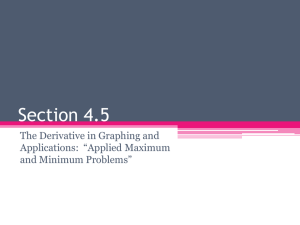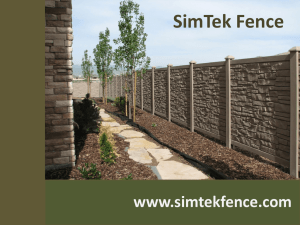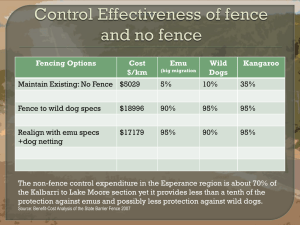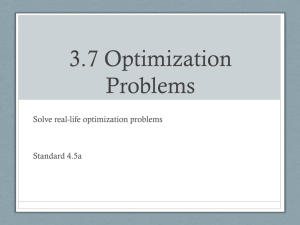Fencing Laws & Design
advertisement
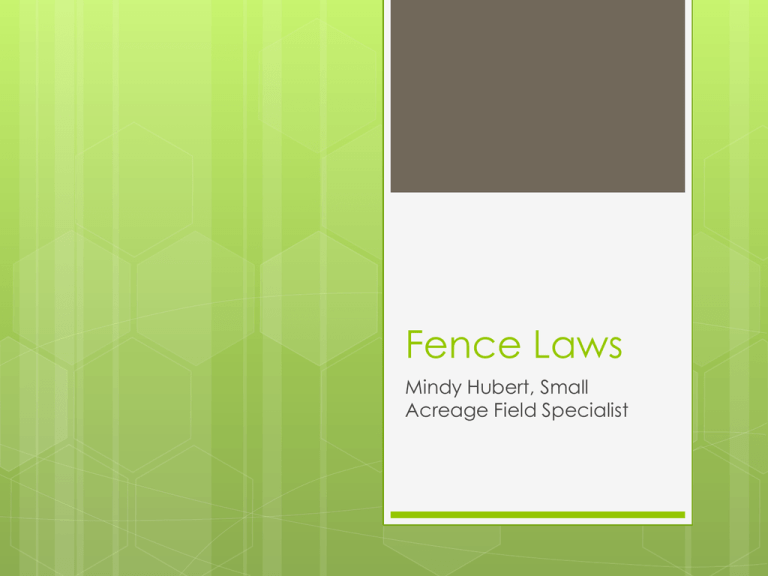
Fence Laws Mindy Hubert, Small Acreage Field Specialist http://legis.state.sd.us/statutes “Good Fences make Good Neighbors” If neighbors can agree on fence construction and maintenance, then there is no issue. “Unless otherwise agreed upon”…precedes all law Common Issues One landowner doesn’t have livestock Still benefits from fence-keeps livestock out Common on newer acreages adjacent to ranches SD Codified Law 43-23-1 Every owner of land shall be liable for one-half of the expense of erecting & maintaining a partition fence. However, no landowner is liable for such expense if: neither landowner keeps livestock on the affected tract of land neither landowner derives any other substantial benefit from the fence for a period of 5 years from the date of erection or repair of the fence. SD Codified Law 43-23-2 Each owner of adjoining lands shall build the half of fence on their right hand when standing upon their own land and facing the line upon which the proposed fence is to be built. Many landowners agree to otherwise Common Issues: neglectful One landowner (with livestock) neglects their fence repair duties 43-23-5: Owner of the adjoining land may serve upon the delinquent owner a notice in writing demanding : delinquent owner shall erect or repair a legal fence along one-half of such line, describing it within 30 days from the date of the service of the notice. Frozen earth exception 43-23-7 protects a delinquent owner from building a partition fence when ground is frozen. Common Issues: neglectful If still no action by negligent landowner, the aggrieved owner may: Recover cost of erecting or repairing the partition fence in a civil action Recover compensation for the time spent Place a lien on negligent landowner Refer to lawyer if answer not clear Common Issues: One landowner has buffalo (or elk) Same laws apply, but owner of “specialized” livestock must pay additional costs over those of legal fence. Common Issues: Trespassing Livestock Chapter 40-28: Permitting adult male animals to run at large Castration lawful for adult male animal running at large Running at large defined. Liability for trespass by livestock--Exception where fence inadequate. Trespass liability not applicable to unfenced lands within national forest Common Issues: Livestock “Running at Large” Petty offense to let male animals “run at large” 40-28-1 =intentionally left outside of legal fence by owner/manager Stallion > 18 months old Bull > 10 months Ram or boar > 8 months Lawful castration allowed under 40-28-2 If neighbors cannot agree to otherwise, then a legal fence must be built legal fence sound wood posts concrete posts 6.5‘ x 4”, firmly set 2 feet in the earth not over 30 feet apart 6‘ x 4” or larger reinforcing rod steel posts At least 5.5‘ long 7 inches in the earth not over 20 feet apart legal fence combination of steel and concrete/wood posts in a ratio of < or = 3 steel posts to 1 of wood or concrete posts must be braced at ends, corners, gateways 4 strands of ordinary barbed fencing wire shall be firmly stretched & securely attached strands @18”, 28”, 38”, and 48” from the earth. A deviation of not more than 2” in wire spacing is in compliance. Fence Design Permanent & Temporary Permanent Fences Consider nature of livestock being contained Horses Sheep & goats Cattle Permanent Fences: Horses Due to flight nature, fences are major cause of injuries Five feet is minimum required height for most horses (nose height) Better to erect new fences than put “band aids” on old fences Permanent Fences: Horses Polyvinyl Split Rail Electric/high tensile Barbed wire (& Modified) Polyvinyl: $5-$7 per lineal foot Advantages Attractive Minimal maintenance Generally safe Disadvantages Professional installation often required Cross-fence contact is possible (depending on height) Sections of fence can break or shatter, depending on quality Split Rail (~$3-$4 per lineal ft.) Cost varies with wood type, # of boards, etc. Advantages: Cedar, oak or treated pine often used Provides rustic charm to properties Highly visible and relatively safe not likely to cause physical harm unless the collision is hard enough to break the rail less likely to get a hoof hung up Disadvantages: Maintenance expense can be significant Permanent Electric (<$1/ft.) Advantages Keeps horses away from fence line Inexpensive Safe, if operating properly Disadvantages Grounding issues in dry climates Harder for livestock & wildlife to see (smooth wire) Training period needed for horses More maintenance/fire hazard Barbed Wire ($1.10/ft. installed) Advantages Cheap Often in place when new landowner arrives Lasts decades Disadvantages Can cause severe damage to horses Especially in smaller areas or pastures Young or inexperienced horses need a babysitter horse or intensive “training period” Modified Barbed Wire Add an electric strand to the top of existing barbed wire fence. Keeps livestock on both sides of fence away Add extended insulators to metal posts to set hot wire away from fence Does not keep animals on other side of fence away from fence line Temporary Fence Electric Why Temporary? Ideal • • • for short-term/rotational grazing Horses are very selective Allows for more grazing control Great for hard to fence areas or driveways Quick and easy set up/tear down Should NOT be used long-term Types of Temporary Fence Usually constructed of electric materials, although may not always be electrified Electric tape or rope With appropriate insulators 1 or 2 strands sufficient Something attached to increase visibility. Sheep & goats Fence Requirements Sheep & Goat Fence/ woven wire < $1/ ft. ~48” tall • 4” or > square openings (5”x6”) • Helps keep predators out/livestock in • Install close to ground and keep tight • May need electric standoff wire on the interior of the fence to eliminate the possibility of heads getting caught in large square openings Electrified netting < $1/ ft. Comes in rolls that may include fiberglass posts for easy installation (For temporary uses) Line Fence for Sheep/Goats • • • • • Cheap= < $0.25/ft. Many combinations of materials (usually electric) Posts are fiberglass, metal or wood. Fence is high-tensile, rope or polywire. Frequent stretching required. Combination Woven/ HT
